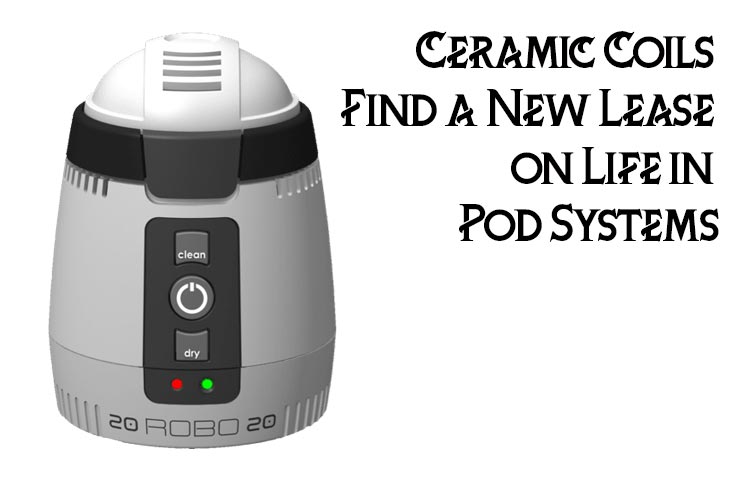Table of Contents
Last Updated on January 11, 2021 by Team Spinfuel
Not too long ago, many people thought that ceramic coils were poised to become the new standard in vaping. Products like the Horizon Krixus tank and the gCeramic replacement coils from Atom Vapes offered pure flavors and extreme longevity – exactly what everyone wants from their vaping experience. To many people, it was a foregone conclusion that ceramic wicks would either replace cotton wicks in most mainstream vaping applications or would at least relegate cotton wicks to niche status.
As it turned out, though, sub-ohm coils with ceramic wicks were essentially a flash in the pan. If you’ve been vaping for less than five years, in fact, it’s unlikely that you’ve ever even heard of the two products mentioned above because they didn’t stick around for long.
While cotton is likely to remain the wick material for the vast majority of vape coils for the foreseeable future, ceramic coils have enjoyed a quiet but steady comeback over the past few years. In this article, you’re going to learn why it might be worth your while to try ceramic vape coils in 2021. First, though, let’s have a little history lesson.
Why Did People Think Ceramic Coils Were the Future of Vaping?
Compared to cotton, ceramic has two major benefits as a wicking material for vape coils.
- Unlike cotton, ceramic doesn’t burn at any temperature that a vaping device can reach. A cotton wick will always eventually fail due to heat stress. Being impervious to heat, a coil with a ceramic wick should last much longer.
- A porous sintered ceramic wick contains no organic material; it’s all burned away during the firing process. A ceramic wick doesn’t interact with your e-liquid in any way and should thus deliver a much purer flavor.
With those two benefits in mind, it’s understandable that virtually everyone in the vaping community once thought that cotton wicks were probably on the way out – but that never actually happened. In fact, ceramic coils for sub-ohm tanks faded away almost as quickly as they appeared. What happened?

Why Did the Ceramic Coil Trend Fizzle Out So Quickly?
If you look at the two classic Spinfuel reviews cited above, you’ll notice that the coils reviewed range in resistance from about 0.3-0.9 ohm. That’s typical of ceramic sub-ohm coils. A ceramic wick can do some things as well as – or better than – a cotton wick, but the one thing ceramic can’t do as well as cotton is transport liquid efficiently from one place to another.
When you take a big, deep puff from a 0.15-ohm mesh coil with a cotton wick, the coil is ready to go again almost instantly. There’s little risk of a dry hit unless you’re really chain vaping. Even in the 0.3-0.9-ohm range, though, a ceramic wick needs a bit of time to refresh itself between puffs. With the super-powerful coils that have been coming out over the last few years, there’s no way that a ceramic wick can keep up.
So, that’s one reason why ceramic wicks fizzled out in sub-ohm tanks; ceramic doesn’t transport e-liquid efficiently enough to keep up with today’s coils.
The other reason why the ceramic coil trend fizzled out so quickly has nothing to do with a shortcoming in the coils themselves. The problem is that the advent of ceramic coils coincided with the massive rise in popularity of heavily sweetened e-liquids. A ceramic wick may be more resistant to burning than a cotton wick, but it won’t do anything about the coil gunk that sweetened e-liquids cause. If you use a heavily sweetened e-liquid and vape frequently enough, you’ll start to notice the telltale burnt taste of coil gunk within just a day or two – and that’ll happen regardless of the type of coil you use.
Unaware of coil gunk and what causes it, some people tried ceramic coils, found that they didn’t last any longer than standard coils and simply ditched them. It’s unfortunate that products like the ROBO2020 automatic vape coil cleaner didn’t exist back then; people would have quickly learned that ceramic vape coils tolerate repeated cleaning far better than coils with cotton wicks. Coil gunk is entirely removable with a bit of water, heat and agitation, and cleaning a ceramic coil can allow you to continue using it for a very long time.
Why Are Ceramic Coils Making a Comeback in 2021?
So, if ceramic coils fizzled out quickly when they were introduced during the 2010s, why have they been slowly gaining in relevance since then? The reason is because lower-temperature vaping has made an enormous comeback in recent years. Many experienced vapers have ditched their mods in favor of smaller pod systems. Most new vapers start with pod systems, and a significant number of those people never bother switching to larger and more powerful devices.
In 2019, the Next Mind CT1 pod system was released. It used a ceramic coil. Although it wasn’t enormously successful, it signaled the beginning of a trend that’s likely to continue because low-temperature vaping brings out the best in ceramic coils.
You get the resistance to heat and the purity of flavor, and the fact that ceramic doesn’t transport e-liquid as efficiently as cotton is irrelevant when you aren’t using a thirsty sub-ohm coil. Of course, you still need to use an unsweetened e-liquid for the best possible coil life – but if you don’t want to do that, you can always grab the ROBO2020 coil cleaner.
Resurgence
The other reason why ceramic wicks have experienced a resurgence in popularity in recent years is because of the increased interest in vaping very thick liquids such as CBD distillates. One of the ways in which cotton and ceramic wicks differ greatly is that, while cotton transports e-liquid more efficiently than ceramic, the opposite is actually true with thick oils.
Many people are finding that, when they buy vape pens for oils, the coils for those pens actually use ceramic by default. So, it actually has turned out that ceramic actually has replaced cotton as the default wick material of choice for one type of vaping, even if that never happened in the world of sub-ohm tanks.








